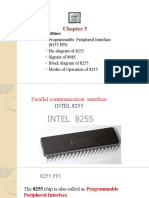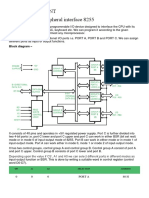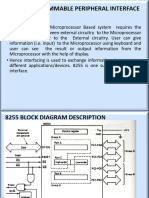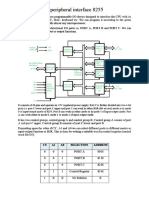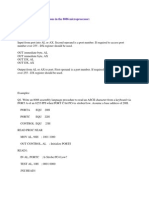0 ratings0% found this document useful (0 votes)
46 views23 pagesUnit-4 MPI
Uploaded by
hofehag577Copyright
© © All Rights Reserved
We take content rights seriously. If you suspect this is your content, claim it here.
Available Formats
Download as PDF or read online on Scribd
0 ratings0% found this document useful (0 votes)
46 views23 pagesUnit-4 MPI
Uploaded by
hofehag577Copyright
© © All Rights Reserved
We take content rights seriously. If you suspect this is your content, claim it here.
Available Formats
Download as PDF or read online on Scribd
You are on page 1/ 23
PROGRAMMABLE PERIPHERAL INTERFACE (PPI) 8255
‘The 8255 (PPI) is a programmable, parallel input/output device. It can be programmed to
transfer data under different conditions, from simple input/output. It is flexible, versatile and
economical (When multiple input/output ports are reqired), but some what complex. It is widely
used with almost any microprocessor.
The 8255 has 40 pins, out of these 24 input/output pins can be grouped in 8-bit parallel
ports : Port A and Port B, with the remaining eights bits as port C. The port C can be used
as individual or be grouped in two 4-bit ports namely, port Cyppr (Cu) and port CLower (Ci)
as shown in fig. 10.1. The function of these ports are defined by writing a control word in
the control register.
Port A
82554
Port ©
Port 8
Fig. 10.1 : 8255 Input/Output ports
‘Scanned with CamSeanner
a lock Diagram of the 8255 ne
rs block diagram is shown in fig, 10.2
‘Various elements and the
ie ir functions areas follows
i is 8 pins (PAo~ PA.) fi in
es = Coisatns a ‘or receiving/sending data it
18 data itis used as 8 bit parallel
port B: Also
used as 8-bit parallel port It contains 8 pints (PBy —
sending data. :
PB;) for receiving’
art C : Used as 8-bit parallel port. It can be divided into two
and Ciower (Cx): It contains 8-pins (PC, —
can also be used for handshake signals,
i) Control Logie
{90 4-bit ports: Cuppee (Cu)
PCr) for receiving/sending data. Port C pins
The control section has six lines. Their functions are as follows: *
RD (Read) : This control signal enables the read operation. This is ative low signal. When
it oes low the microprocessor reads data from a selected input/output port of the 825
oe
Fe
mics Bel OEO=
eft Gag PAPA,
Supplies Guo pf A a
conto
+
foe
n v0.
Ne
spe
Bidirectional Data Bus Mie
Dy
cl
WR
a
nt
Reset
‘Scanned with CamSeanner
Pin Configuration
Pat of PA,
Pa, 2 30/51 PA,
Pa, 3 385A,
PA, ea arpa,
RDC|s WR
wsef5 35/5 reser
no c|7 Bo,
acts 3650, 0,» Data Bus(Beirectona
acs 32/50, reser Reset input
PC, C10 .8255A 31 Foe
rein soo, s idee
PC, 12 2k, Ro Readinput
Po, 13 20,
peste abo, Wt input
PC, 415, Ev. Port Adress
Po, 16 258, PA, PA Port (Bt)
Po, 17 24 pe, Pcr-PC) Pon 8 (61)
8, 18 23 ps, Vee +5:Vols
Pe, H19 2b pe, aS 0 Vote
8, {20 21 ps,
Fig. 103 : Pin configuration of 8255
WR (Write) : This control signal enables the write operation. This is also an active low
signal. When it goes low, the microprocessor writes into a selected input/output port or the
control register.
RESET(Reset) : It clears the control register and sets all ports in the input mode. Its
active high signal,
(ii) Address: Logic
‘Aq Ai + These pins are generally connected to microprocessor address lines - Ay and
Ay The combination ofthese two is used to identify the address of various ports and cont!
register. For this purpose internal decoder is used.
‘Scanned with CamSeanner
4l
Register
EN
cs
a | tet
Ay intemal p2->c
‘i Decoder [Ot >
Lex fo>4
Fig. 10.4 : Control Logic diagram of 8265
CS (Chip Select)
Itismaster chip select signal. Itis active low signal. When t oes low chip will be selected,
‘Address line other than Ay and A, may be used in-any combination to make the chip select
ogc.
Addresses of ports and control register can be determined b
lines. This is shown in table 10.1 and in fig. 10.4
Table 10.1 : Address decoding for 8255
yy combination of CS. Ar, Ao
a i Port Selected
0 0 a Porth
° o z rote
o 4 = Pon ¢
5 7 1 onto! Register
: 7 x 7255 nol seleced
‘Scanned with CamSeanner
(iv) Control Register
Register which is internal to the 8255 chip is called control register. The contents of thi,
register are known as the control word, Control word specify inpu/output function and modes
of various ports of 8255.
Control register can be accessed to write a control word when both Ag and Ay are
high(shown in table 10.1).
10.2.2 In terfacing Steps
To communicate with peripherals through the 8255, three steps are necessary.
1. Determine the address of ports A, B and C and of the control register by the use
of chip select logic and address lines Ag and Aj.
Determine the control word and write it into the control register.
3. Write input/output instructions to communicate with peripherals through ports A, B
and C.
‘Scanned with CamScanner
40.2.3 Modes of 8255
All the functions of 8255 are classified according to two modes.
(BSR (bit set/reset) Mode
(i) Input/Output Mode
The modes of 8255 are shown in fig. 10.6.
Control Word
Dee,
ol
BSR Mode Input/Output Mode
(Bit Set/Reset)
For Port C Mode 0 Mode 1 & ote 2
Mode Simple Handshake directional
eit Input/output for inpuloubut em for
Band C por
ee, eee andlor B
Port C bits Port B; either
are used for in Mode 0 or 1
handshake
Port C bits are
used for
handshake
‘Scanned with CamSeanner
BEE) PROGRAMMABLE INTERVAL TIMER (PIT) — 8253/8264
The 8253/8254 programmable interval timer is similar to software designed counters and
timers. Accurate time delay can be generated by both 8253 and 8254. Software techniques
for generation of time delays are not accurate and makes microprocessor busy in delay loop.
Thus to overcome this difficulty additional hardware in the form of 8253/8254 is used.
8253/8254 can be used for applications such as a real-time clock, an event counter, adigital
fone shot, a square wave generator and a complex waveform generator,
The 8254 includes three identical 16-bit «
‘one of the six modes.
ers that can operate independently in any
Iris packaged in 24-pin DIP and requires a single + SV power supply.
To operate a counter, a 16-bit count is loaded in its register and, on command, begins to
decrement the count until it reaches to 0, At the end of the count, it generates a pulse that
can be used to interrupt the MPU. The counter can count either in binary or BCD.
8254 is an upgraded version of the 8253, and they are pin-compatible,
The features those differ for both devices are —
1, The 8254 can operate with higher clock frequeney range (DC to 8MHz) and the 8253
ith clock frequency range (DC to 2MHZ).
2. The 8254 includes a status read-back command that can latch the count and the status
of the counters,
‘can operate
The pin diagram of $254 is shown in fig. 10.21
in Configuration
oft Bp ve.
oe 23a WR
pcs 22/5 RD
os apace
o.cfs 2a,
cs wha,
7 isc,
o.cys 175 out,
cx cf 10 care,
: out, }10 ssa,
care, 11 14 our,
ono | 12 13Ficate,
Fig. 1021 : Pin dlagam of 8253/8264
‘Scanned with CamSeanner
40.3.1 Block Diagram of the 8253/8254
Figure 10.21 is the block diagram of the 8254; i i
data bus buter, read/write control logic and a control register. F
(CLK and GATE) and one output signal (OUT)
(@ Data Bus Buffer
This tri-state, 8-bit, bidirectional buffer is connected to the data bus (Dy ~ D3) of the
microprocessor. The data bus bufler has following,
includes three counters (0, 1, and 2), @
ach counter has two input signa}
basic functions
(a) Programming the 8253/8254 in various modes
(b) Loading the count register:
(©) Reading the count value
(i) Controt Logie
The control section has five signals.
ve low signal which is used to read the value of the counters,
RD (Read) : It is an a
For peripheral mapped 10 mode, itis connected to TOR signal and for memory mapped VO
mode, MEMW signal is connected to this pin.
ive low signal which is used to write command or data in counters
or control register. For peripheral mapped UO mode, JOW signal is connected to this pin and
for memory mapped 1 mode MEMW signal is connected to this pin.
‘Ay Ay t Microprocessor address lines Ay and Aj are connected to these pins. Combination
of these two pins are used to identify various counters and control register
€S (Chip Select) : It is an active low signal to make chip select logic, address lines other
than Ag and A; may be used in any combination. If signal at this pin is low, then the 8253/
£8254 will function; otherwise it will not
Table 10.2 : Address decoding for 8253/8254
ss Ai & Selected Counter
2 a 0 Counter 0.
2. wy 1 Counter 1
2 z 0 Counter 2
2 4 1 Control Register
- us x a2sva2a not selected
‘Scanned with CamSeanner
Counters
The chip 8253/8254 includes three 16-bit counters namely : Counter 0, Counter 1 and
counter 2, These are presetable down counter: Each counter has is own 16-bit count epister
to set the count value for the respective counter. The following signals are related to these
counters
CLK 0, CLK 1, CLK 2 (Clock Signal): These are input signals for counter 0, counter 1,
counter 2 respectively. To g i
werate delay, contents of the respective counters are decremented
ATE 0, GATE 1, GATE 2 Gate Signal) : These are input signals for counter 0,
counter 1
tr 2, respectively. To start and stop counting of the respective counter, GATE
sianalis used. When GATE signal is high, the counting starts and when it goes low, the counting
stops:
OUT 0, OUT 1, OUT 2 (Output Signal)
1, counter
These are output signals for counter 0, counter
respectively. OUT signal goes high when contents of a counter reaches to 720
itean be used as an interrupt signal for microprocessor to indicate that the counting has been
completed.
(iv) Power Supply
Vcc ~ It is connected to + SV.
GND ~ It is connected to OV.
oh
can
oe) Bee [ceo
2% puter
Sass sees
=e
=e
A ——>| onic
A
oa
Control
‘word
register
Fig, 10.22 : Block diagram of 8253/0254
‘Scanned with CamSeanner
(©) Controt Word R
This register selected when line Ap and A, are a logic 1 (AoA) = 11). It is used to wrig
‘ 3 the counter to be used, its mode and either a read oF a wig
10.23.
‘a command word which spec
‘opration. The control word format is shown in fi
>] a a] o af [9 a
Sy SGM OM
$C ~ Select counter M— Mode
$6 | 8 im | ms | my | Mode section
[0 | Select counter 0 o fo [0 | Mode 0
0 | 1 [select counter + o Tots | mois
+ | 0 | Select counter 2 x [To [ede 2
egal for 8263 = [Ts | odes
1 | 1 | Reaa-Back command for 8254 atofot odes |
(See Read operations) i ee
RW — Reaamrite
RW, | RW B00:
© | © | Counter tate command © | Binary counter 16 — bis
(See, Read operations) 1,| Binary coded decimal (CD)
© [_1_| Reaarwte fast signifcant byte only Counter (4 Decades)
+ [9 | Readirte most signfcant byte only
1 | 1 _| Readiwite least signiicant byte frst
then most significant byte
Note : Dont care bits (~) shoul be 0 10 ensure compatitiliy with fre Intl products
12 10.23 : Control word format for 82638264
10.3.2 Modes of Operation of 8253/8254
‘The 8253/8254 can operate in six different modes by writing.a suitable control word. Thes®
modes are described below :
( Mode 0 + Interrupt on terminal count
(2) Initially output will below after the mode set operation
(b) After the count is loaded into the count register, the output will remain low and the
counter will count
‘Scanned with CamSeanner
fo, When counter reaches to zero the out wll go high an
j rebated. This cn be wel aan mempsipal cere
gal to microprocessor
spe coniton 1 enable counting is GATE =.
i ig, 1026 shows tha the counting (m ~
sacporrlysopped, when the GATE is disabled and counting sas spain hen te GATE
isat logic |
ox_J | ee a ea Pe
re 3 7 ee ee
owe ae ae
eee
Bae, rararc naviesate Omer
(a) The output wil be initially high.
(b) When the count is loaded and GATE is triggered, the out signal goes low. The count
saris now.
(6) Atthe end of the count, (count reaches to zero) the out
fone shot pulse.
‘When the trigger input is applied again,
signal low: In this mode, the 8253/8254 can be used as
Yaveforms for various signals in mode 1 of 8253/8254 are shown in fig. 10.25
ut goes high. This is like the
the counter will estar counting by making OUT
‘4 monostable multivibrator. The
ux
am
‘Scanned with CamSeanner
Mode 2 : Rate Generator
This mode functions like a divide by-N counter
(@) The output willbe initially high.
(©) The output will go low for one clock pulse before the ten
(©) The output then goes high, the counter reloads the initial count and the process is
repeated
(@) The period from one output pulse to the next equals the number of input counts in
the count register.
‘The count = isillegal in this mode. IfGAT
counting.
itenables a counting; otherwise it disables
= nL
mes eS
Fig, 10.28 : Mode 2 : Rate Generator
(iv) Mode 3 : Square Wave Generator
This mode is designed to be periodic. The output of this mode is square wave signal. The
‘count value for this mode could be even or odd. ‘The operation of 8253/8284 for odd and even
‘count is different
Even Count
(a) Initially outputs high,
(b) Counter is decremented by 2 on the falling edge of each clock pulse.
(©) When the counter reaches to zero, the state of output is changed (low to high or high
to low)
(@) The counter is reloaded with full courit and whole process is repeated.
Odd Count
(@) Initially outputis high,
(b) The count is loaded, the first clock pulse decrements the count by 1, subsequent clock
pulses decrement the count by 2,
(©) When the counter reaches to zero, the state of output is changed (igh to 1)
‘Scanned with CamSeanner
Tt it is reloaded, the first cl
1) The count is » the first clock pulse decrements the count oi
jock pulses decrement the count by 2. oe Sh by Stabeewiatt
{@) When the counter reaches to zero, the state of output is changed (low to high).
{9 The counter is reloaded with full count and whole proces is repeated.
yorious waveforms for mode 3 of 8253/8254 are shown in fig. 10.27.
aSUUUU LA
je ea eet eet aed
eS aerials ee lot
la ie to ae ie
1 eee :
Fig. 10.27 : Mode 3: Square wave generator
ee et ee ee
‘Nate: Ifthe count (N) is even, N/2 clock pulses provide the upper half of the square wave and
'N2 clock pulses provide the lower half. Whereas if the count (N) is odd, the wave stay high for =,
(+ 2 clock pulses and stay low for (N ~ 1)/2 lock pulses. 5
t
(8) Mode 4 : Software Triggered Strobe 5
(@) The output is initially low.
(©) At the end of the count, the output goes low for one clock pulse:
This mode is similar to mode 2, but itis not periodic. The count is not automatic reloaded;
ace foaded again for subsequent outputs. The waveforms for mode 4 are shown in fig.
128,
‘Scanned with CamSeanner
(vi) Mode 5 : Hardware Triggered Strobe
(a) The output will be initially high.
(b) The counting is triggered by the rising edge of the GATE.
(©) The output will go low for one clock pulse at the end of count.
This mode is similar to mode 4, except that it is triggered by rising edge of the pulse at
the gate.
= J 4 eS ee See
Wns a ee Si ae
Biter clei tig! sf ltet oe e
Crete ee ri of i Pel a
ppp A ee
Ore ia ee eee cloner
Fig. 10.29 : Mode 5 : Hardware Triggered Strobe
Note : In mode 5, if another trigger pulse is applied through GATE before the counter reaches
to zero, the count is reloaded and counter will restart. This is called retriggering,
‘Scanned wih Gamseamer
PROGRAMMABLE INTERRUPT CONTROLLER (PIC) ~ 8259
The 8259 can be used by provide additional interrupts other than software and hardware
interrupts of 8085 microprocessor. The $259 interrupt controller can
@ Manage eight interrupts according to the instructions written into its control registers
This is equivalent to providing eight interrupt pin on the processor by connecting to
it INTR pin of 8085 microprocessor. Thus, we have total 12 interrupts lines by using
one 8259(8 new and 4 earlier interrupt lines) (TRAP, RST 7.5, RST 6.5, RST 5
with the loss of INTR line)
Gi) Vector an interrupt request anywhere in the memory map. However, all eight interrupts
are spaced at the interval of either four or eight locations. This eliminates the major
drawback of the 8085 interrupts in which all interrupts are vectored to memory
locations on page 00H.
(iii) Provides eight levels of interrupt priorities in a variety of modes, such as fully nested
mode, automatic rotation mode, and specific rotation mode.
(iv) Mask each interrupt request individually
s, in-service interrupts and masked interrupts.
(v) Read the status of pending interrup
(vi) Be set up to accept either the level-triggered or the edge-triggered interrupt request.
(vii) Be expanded to 64 priority levels by cascading additional 8259s.
(si) Be set up to work with either the 8085 microprocessor mode or the 8086/8088
microprocessor mode.
‘Scanned with CamSeannes
_— ;
“pat Block Diagram of 8259
Fig, 10.33 shows the internal block diagram ofthe 8259. 11 ineludes eight blocks : control
s eight blocks : contro!
idiwrite logic, data bus buffer, three re
i gisters (IRR, ISR, and IMR), prio cl
buffer: The diagram shows all the elements of a oa fad epi
locks. The fution-of thesebleels are ai follans me ee
tose, Fe
and casende
additional
4, Control Logic
‘This block has two pins : INT (interrupt) and INTA (interrupt acknowledge). The funetion
of these are
(INT (Interrupt
asserted, this signal goes high. Th
interrupt is
tis an active high output signal. Whenever a vi
sonnected to INTR pin of the
INTA (Interrupt Acknowledge) : It is an active low input signal. The INTA
interrupt acknowledge signal from the microprocessor, This is connected to INTA
pin of the microprocessor.
2, Read/Write Logic
Read/Write logic has following signals
) Ay: When the address line Ao at logic 0, the controller is selected to write a command
or read a status. This is connected fo Ap address line’of the microprocessor
RD (Read), WR (Write) and CS (Chip select) + These pins have their usual
functions.
3. Data Bus Buffer
It has bidirectional data pins (Do
microprocessor. The data buffer allows t!
status word from the 8259.
4. Cascade Buffer/Comparator
This block is used to expand the numberof interrupt levels By ‘cascading two or more 8259.
The pins associate with this block are
(CAS 0 — CAS 2(Caseade Hines) +
8259 in cascade mode.
connected to the data bus of
— Dy). These pins are
trol words to 8259 and read a
he 8085 to send con
‘These lines are used fo connect more than one
sffer) + It is used to define the 8259 as master!
(i) SP/EN Glave Programv/Enable 8
itoper
than one 8259 are use
re, with 5P/EN connected to
rates asa master. Then SP/EN pinis connected
slave, When single 8259 is used,
‘one 8259 can be
to + SV (logic 1). When more ) are high it means that the request is stored and the corresponding
IRR bit is set.
(i) All the three registers are checked by priority resolver and INT pin set high.
Gil) Microprocessor acknowledges the interrupt by sending INTA pulse.
‘Scanned with CamSeanner
When INTA pulse is received form the microprocessor the ISR bit with the highs
is set and the cor ing pee ee
priority is set andthe corresponding IRR bits reset. Ther after call instruction cod
(CD His set on pin(Dp ~ D>). Since all the RST instructions re 1 byte call a 5
are | byte cal instruction
having some vectored location
9) Two more INTA signal on the data bus are placed while decoding the CALL
instruction.
(oi) Thetwo INTA pulses are defined as that lower 8 bit address i released at the second
her 8 bit address is released at third INTA pulse. It completes
NTA pulse and the hi
the 3 byte CALL instruction,
TA pulse; the ISR bit is reset either automatically with the help of AEO!
(iy At thied TN
of
(Automatic End of Interrupt) or by a command word should be given at the en
subroutine which is determined by intialization command word
10.43 Priority Modes
Many types of priority modes are av
during the program by writting appropriate command words,
commonly used are as follows
lable with 8259. They can be changed dynamically
Priority modes which are
(0 Fully Nested Mode
iets mde the inverrustxqsiatom IRs IRqate arises emslebest © lowes
pry, IR, is having highest priority and TRy is having the lowes! pron ‘When an interrupt
itcinowledged, the highest priority request is detrnined and is Yociorl0a00 placed,
on the bus. Also any IR can be set to highest priority
SS ee Rm mn)" |] ®
DLs - 5 . ° 1 2 3
+ z
Lowest Highest
Priory ‘Pry
interrupting devices.
i) Automatic Rotation Mode =a a
rity assigned to no, of i
(eed regeives the lowest
ih ]
some applications there ean be edu served
Bis te help af ais mode, the mare stert ance. oa
Pron,
‘Scanned with CamSeanner
IR IRs IRe IR,
1 2 3 4
Lowest
Priority
Assuming that IR has just been serviced, it will receive the seventh (lowest) priority.
(iii) Speicifie Rotation Mode
In this mode user can select any interrupt request for the lowest priority. The programmer
by programming the bottom priority and fixing other priority can change any priority.
‘Scanned with CamSeanner
KEYBOARDIDISPLAY CONTROLLER - 8279
a matrix keyboard and multiplexed display.
The 8279 is a hardware approach to interfa
Software approach is also possible to interface keyboard and display unit. The disadvantage
of the software approach is that the microprocessor is occupied for a considerable amount
of time in checking the keyboard and refreshing the display
‘The 8279 is a 40-pin device (shown in fig. 13.7) with two major segments : Keyboard
and display. The keyboard segment can be connected to a 64-contact key matrix. Maximum
8 keyboard entries (codes) can be stored in the FIFO (First In First Out) RAM. Every time,
a key is pressed, an interrupt signal is generated, to request the microprocessor to read the
key code.
‘The display segment can provide a 16-character scanned display interface with such
devices as LEDS. This segment has 16 x 8 R/W memory (RAM), which can be used to read/
Write information for display purposes. The display can be set up in either right-entry or left—
entry format.
‘Scanned with CamSeanner
at
wen
slam,
37 enrusta
ee | ace RUC
A,
1
a 2
RQ Rly CLK 9.
ROL 4
Pee 5
6
1
Key iat 36 | SHIFT
da RU, ira:
§ Ay 4 pos,
i RL} 8 abs,
3 Son eseri 6 a
y FO. ‘OUT B,
WRC = our,
ba, ‘OUTB,
ee aie ours,
ii DB, OUTA,
= DB, OUTA,
08, ouTA,
0B, UTA,
a, a
8, S
A
Pi contiguraion
Fig. 137 : Pin Diagram of 8278
13.4.1 Block Diagram of 8279
The block diagram is shown in ig.
section, Scan section, Display section
1. [Keyboard Section]
The function of various pins of this section are
Se haeaaicst Tommasi nt 3st a, conpeted a IGA RD URE of
4 keyboard.
( smnr : 1
shift input status is stored.
into four major sections : Keyboard
3.8, Itean be divid
‘and Processor section.
is used {nthe scanned Keyboard. On key closure or key is closed the
‘Scanned with CamSeanner
Gil) CNTLISTB (Control/Strobe) : The status of the SHIFT key and the control key
cean be stored along with a key closure. The keys are automatically debounced, and
the keyboard can operate in two modes
(a) Two-key lockout mode : In the two-key lockout mode, iftwo keys are pressed
simultaneously, only the frst key is recognized.
(b) N-key rollover mode : In the N-key rollover mode, simultaneous keys are
recognized and their codes are stored in the internal buffer; it can also be set
up so that no key is recognized until only one key remains pressed.
[Sa Seton]
‘The scan section has @ sean counter and four scan lines (SLo ~ SLs). These four scan
lines can be decoded using a 4-to-16 decoder to generate 16 lines for scanning. These lines
‘can be connected tothe rows ofa matrix keyboard and the digit drivers of a multiplexed display.
3. [Display Section!
The
ese lines ean be used, either as a group of eight lines or as two groups of four, in combinat
‘The display section has eight output ines divided into two groups Ay ~ As and By ~ By.
‘with the scan lines for a multiplexed display. The display can be blanked by using the BD
line. This section includes 16 x 8 display RAM,
4.
[Processor Section
‘The function of various pins of this section are
() DB, —DB, : These are bidirectional data bus lines, used to transmit the commands.
Gi) IRQ: Its an acti
FIFO RAM. This
availability of data.
high signal. It goes high whenever data entries are stored in
ignal is used to interrupt the microprocessor to indicate the
‘Ag: When Ay is high, signals are interpreted as control words or status. When Ag
{goes Tow, signals are interpreted as data
(iv) €S(Chip Select) : It is an active low signal and used to enable the chip.
(¥) RD (Read) : It is an active low signal and used to read the input.
(vi) WR (Write): It is an active low signal and used to write the input.
(vii) CLK (Clock) : It is used to generate internal timing.
(vill) RESET : It is active high signal and used to reset the 8279.
‘Scanned with CamSeanner
—- WR
RD | a IRQ
Eee ee)
Data v0
Buffers [—] contro ae
RESET as,
cux|
Tntemal data bus @)
ospay |. 10x28 | | Lfconnorand|e! [ex k= keypoora
address [>| display | L 5] ~ timing FIFO/senor debounce
registers RAM || registers aM and control
Dipiay "a L
rogers |__| como | _[ecancoinir] —[Retum
i U a
‘Scanned with CamSeanner
You might also like
- 862 Microprocessor and Microcontroller Lecture 16 Interfacing @SEM2JOBNo ratings yet862 Microprocessor and Microcontroller Lecture 16 Interfacing @SEM2JOB36 pages
- 8255 PPI Pin Configuraion and ArchitectureNo ratings yet8255 PPI Pin Configuraion and Architecture21 pages
- 8255A Programmable: Peripheral Interface (PPI)No ratings yet8255A Programmable: Peripheral Interface (PPI)26 pages
- #Tutorialspoint Programmable Peripheral Interface 8255: Block DiagramNo ratings yet#Tutorialspoint Programmable Peripheral Interface 8255: Block Diagram26 pages
- The IN and OUT Instructions in The 8086 MicroprocessorNo ratings yetThe IN and OUT Instructions in The 8086 Microprocessor10 pages










